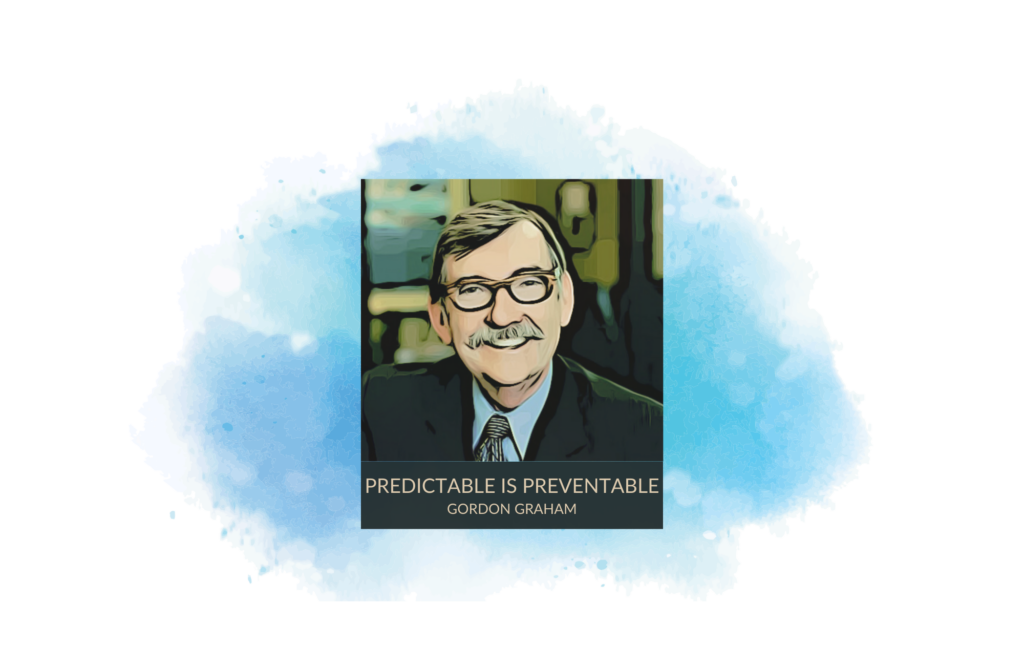
If you’ve attended any public safety conferences or trade shows, you’ve probably heard the legendaryGordon Graham deliver a keynote. For those who don’t know him, he’s a risk management guru, attorney, a founder of Lexipol, 33-year veteran of California law enforcement…the list goes on.
He famously stuck with the overhead transparency for presentations instead of PowerPoint throughout his speaking career. After the session, Gordon would give some lucky attendee the transparency, filled with his colorful charts, arrows, circles, zigs, zags—a veritable Rorschach test of public safety wisdom. It’s been said that some nefarious souls have sold their keepsake on Ebay!
Why are we discussing this luminary here, in a blog typically dedicated to marketing to public safety? Because his consistent refrain, repeated time and again in his speeches, writing and videos, is quite relevant to this discussion, as well:
“Predictable is Preventable.”
In the context of public safety and those who serve inlaw enforcement,fire-rescue,911 andEMS, the message is clear. If you know something has a chance of going badly, why aren’t we making sure we manage that risk from the get-go?
A Graham story that always sticks with me is this: He once told his dear wife in no uncertain terms that if you’re on the highway, and you see someone driving with three mattresses stacked on their roof, tied down with a fraying rope…do not drive behind them. That’s Floppy-Ass Mattress Man, and you don’t ever want to be behind Floppy-Ass Mattress Man.
Simple advice, and relevant for all of us in our daily lives. Even when it comes to marketing.
There are some common mistakes that are just so darn preventable. Yet why do we see these mistakes again and again?
With a tip of the hat to the iconic Gordon Graham, JD, here are our top predictable and preventable mistakes inmarketing to public safety.
1. Can you be trusted?
When you overpromise, underdeliver and make claims that you can’t back up…well…you’re suddenly a nobody to public safety. Uh, bye bye.
We’ve written plenty abouttrust and how it’s the #1 brand attribute to public safety. So why do organizations still break this cardinal rule? Sometimes it’s a big Fortune 500 company that figures if the marketing approach works for video gamers, it will work for first responders. Sometimes it’s a start-up company looking for a shortcut to success.
Build trust with your customers and partners. Steadily, consistently. You will reap the rewards.
2. Start with strategy
It’s so tempting. You just want to start doing stuff. Placing ads, going to conferences, buying sponsorships, sending emails. And once you start down this road, it becomes status quo and you’re not sure why. Whether it works or not, you spend good money after bad. And like an atmospheric river, it builds and builds.
Then the industry media and associations see what you’re doing, and they convince you to spend money with them, too.
Stop. Take a breath. Look up, and build out a marketing and communication strategy. You’ll spend more time doing things that will make a difference and less time doing, well, stuff.
An example: Instead of deciding to go to a conference and buying media and sponsorships haphazardly, decide what you want your outcomes to be. What activities before, during and after the event will help accomplish those outcomes? We bet it will look different with a strategy than without, and likely save you time and money.
Don’t be Floppy-Ass Mattress Man!
3. Know your audience
Why do so many marketers send leadership messages to line officers, firefighters, EMS personnel and dispatchers? Why are they also sending first responder messages to the Chiefs and Directors? Your communication should betailored to the right people. They’re all really busy. So take the time to get this right.
Similarly, don’t assume that just because your product or service is appropriate for all public safety disciplines that you don’t need to craft unique messages. What’s important in the world of fire suppression is going to be different from the world of emergency communications and dispatch.
4. Enlist customers to tell your story
So many organizations miss this. Like snake oil salesmen of yore, they proselytize about how amazing their product, service or technology is. They may even have some data to back it up. But that will never measure up to the words of a public safety customer’s voice, which rise above all else in terms of credibility.
Every public safety leader looks to theinsights of peers—both what’s working well and what’s not. If you have a new product or service, find public safety leaders who will talk about why the solution is important and how it can help. They won’t be guaranteeing success, but they are often willing to go on record when they see a solution they feel will solve a wicked problem.
5. Build personal connections
Organizations that think they can just turn on their marketing automation and Google ads and then sit back and watch adoption in public safety unfortunately learn this lesson the hard way: You can’t do it without connections and relationships.
Surround yourself and your team with public safety thought leaders and subject matter experts. Take time to develop relationships with industry associations, media, distribution partners—heck, even the competition.
It’s amazing how these connections create a compounding goodwill effect. Everybody knows somebody in public safety that you should know.
Get out of your office, or your kitchen counter command post, and build these relationships in the real world. And, of course, use LinkedIn and other virtual platforms.
As the late great James O. Page, founding publisher of JEMS (Journal of Emergency Medical Services) often said: Decisions are made by those who show up.
Bottom line is you can’t make it in public safety without surrounding yourself with good people.
6. Don’t be lazy
Why do we keep seeing the same horrible stock photos on websites, ads and trade show booths? You know, the ones featuring models in fake uniforms. The business suit-clad call-takers who don’t look anything like a 911 telecommunicator. The firefighters in Euro space helmets.
It looks like you’re not even trying.
Relying on the hero messaging is another rather lazy approach. Public safety leaders and first responders alike are looking for information that can help them do their important work. Leave the hero messaging for the citizens and elected officials who rightly should show their appreciation. (Although, adequate budgets for public safety would be even better.)
First responders train tirelessly, putting in the time and energy to be their best. Those in the business of creating solutions and marketing them should care about what we do just as much.
7. Be a great listener
Let’s agree right now: The era of the sales pitch is over. Our sales and marketing people need to ask incisive questions and be amazing listeners. This is the path to public safety enlightenment. Death by Powerpoint is a thing of the past (we hope).
Overwhelming your audience with words, words, words will never equal the results of a conversation. Public safety leaders and practitioners love to share stories and will give careful and considered answers to your good questions.
8. Educate, don’t sell
If you explain to public safety the problem you solve, and why your solution solves it amazingly well, you’re educating, not marketing.
If you can honestly say that your content and communication is geared to educating rather than promoting, you’ll end up ahead. In addition:
- Never use a high pressure approach
- Use more facts and data, less adjectives
- Focus on how you help solve a problem
- Be clear and concise
- Don’t use tech jargon
An Ounce of Prevention
There’s another relevant Gordon Graham story. He was a rookie motorcycle cop in California. Before his first day on the job, he polished and shined his motorcycle from front to back, top and bottom. He proudly got on and started his patrol. Young Graham soon figured out that polishing your seat isn’t a great idea, as he slipped and slid all over and nearly crashed. From that point on: Preventable.
Marketers: Beware of too much polish.
If you need help with your strategic marketing and communications to more effectively reach leaders in public safety,we’d love to start a conversation.
Related Posts
-
It’s easy in tough economies to want to bypass strategy and go straight to tactics.…
-
We’ve all been there. You work for months on a marketing campaign, only to deploy…
-
We’re hoping your holiday season is full of good food, good people and good cheer.…

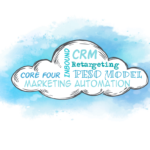


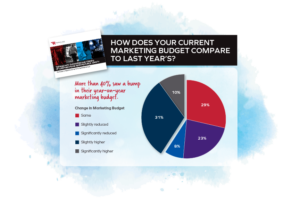
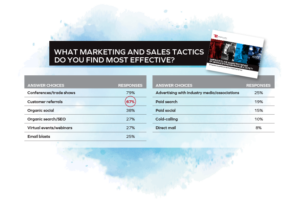
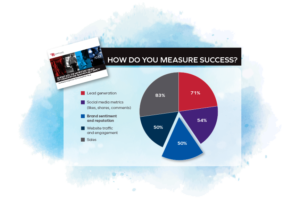
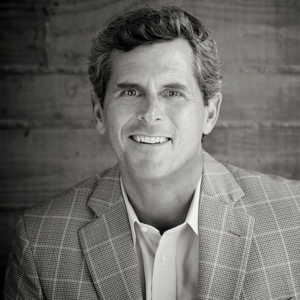

 The RedFlash Group is a GSA Contract Holder under Schedule 541, Advertising and Integrated Marketing Solutions
The RedFlash Group is a GSA Contract Holder under Schedule 541, Advertising and Integrated Marketing Solutions